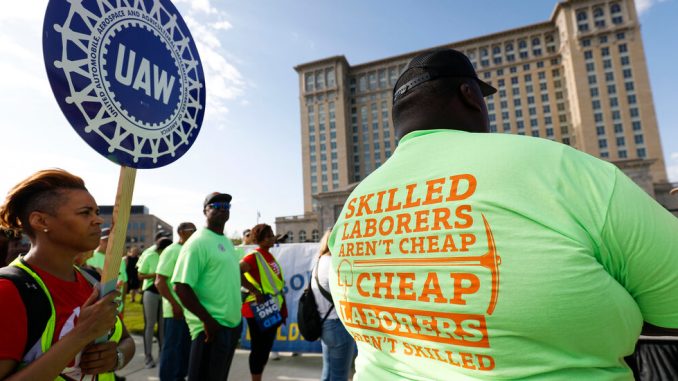
Negotiators for the United Automobile Workers union and the three large U.S. automakers — General Motors, Ford Motor and Stellantis, the parent of Chrysler, Jeep and Ram — remained far apart days after the limited strike began on Sept. 15.
The strike is not a full-scale walkout by the union’s roughly 150,000 members but a “limited and targeted” work stoppage by about 12,700 workers that the union has threatened to expand if talks remain bogged down. It began after workers’ four-year contracts expired.
The union must negotiate separate deals with each of the companies on issues including pay and retirement benefits.
What is the union seeking?
The U.A.W. has demanded a 40 percent wage increase over four years — an amount that union officials has said matches the raises the top executives at the three companies have received over the last four years. Those raises are also meant to compensate for more modest increases the autoworkers received in recent years and the concessions the union made to the companies after the 2008 financial crisis.
The union is also seeking cost-of-living adjustments that would nudge wages higher to compensate for inflation. And it wants a reinstatement of pensions for all workers, improved retiree benefits and shorter work hours, as well as an end to a tiered wage system that starts new hires at much lower wages than the top U.A.W. pay of $32 an hour.
What have the companies offered?
As of Sept. 15, the companies offered to raise pay around 14.5 percent to 20 percent over four years. Their offers include lump-sum payments to help offset the effects of inflation, and policy changes that would lift the pay of recent hires and temporary workers, who typically earn about a third less than veteran union members.
On Sept. 16, a top Stellantis executive said the company had proposed “job security” for about 1,350 people who lost their positions at a plant in Belvidere, Ill., that was closed indefinitely in February. Saving the plant was one of U.A.W.’s priorities going into bargaining. The union rejected the Stellantis proposal before the strike started.
What have the negotiators said publicly?
The companies say that they are investing billions in a transition to battery-powered vehicles, which makes it harder for them to pay substantially higher wages. They say they are at a disadvantage compared with nonunion automakers like Tesla, which dominates the sales of electric cars.
G.M. said in a statement on Sept. 14 that it had made a new offer to the union and that the company was engaged in “continuous, direct, and good faith negotiations” in an effort to avoid a strike.
Declaring that “the future of our industry is at stake,” Ford said on Sept. 13 that it was “ready to reach a deal,” adding, “We should be working creatively to solve hard problems rather than planning strikes and P.R. events.”
Stellantis also said on Sept. 13 that its “focus remains on bargaining in good faith to have a tentative agreement on the table before tomorrow’s deadline.”
The U.A.W. president, Shawn Fain, has consistently said that the union will not settle for less than the 40 percent wage increases.
“If we don’t get better offers and we don’t get down to taking care of the members’ needs, then we’re going to amp this thing up even more,” Mr. Fain said in an interview with CBS’s “Face the Nation” on Sunday.
Mr. Fain said on Tuesday that the strike would expand to more plants if “we don’t see serious progress to noon Friday, Sept. 22.”
What will striking workers get paid?
The union plans to pay striking workers $500 per week and cover the cost of their health insurance premiums. The union’s $825 million strike fund is big enough to cover payments to workers in a full strike against all three companies for about three months — although the U.A.W. has said it would expand the limited stoppage only if talks were bogged down.
What does the strike mean for consumers?
Only certain models of cars are affected right now, but if the strike lasts long enough to start affecting inventories, car dealers will have fewer vehicles on their lots and may start pushing up prices on the ones they do have.
This comes at a time when car prices had already been rising, and the average interest rates on auto loans had been climbing — making it harder for buyers to afford cars.
Daniel Victor and Jack Ewing contributed reporting.


Be the first to comment